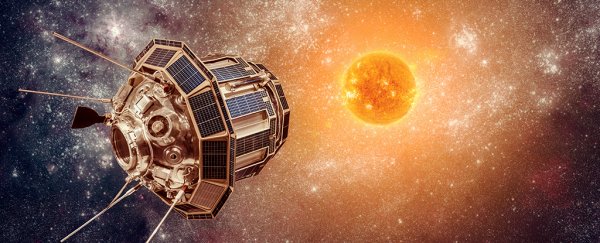New research has demonstrated the feasibility of a rather creative solution to the challenge of sending large amounts of data over interstellar distances; we could use the Sun's gravity.
The same lensing effect that has allowed astronomers to see galaxies at the edge of the Universe would also focus streams of information beamed from probes we've sent to explore other stars, potentially boosting their signal enough to overcome the need for supersized receivers.
German astrophysicist Michael Hippke recognised a major problem we will need to solve if we ever want to send probes to nearby (or even far off) stars will be staying in touch.
Even the most focussed signals slowly spread out over the ridiculously huge expanses of space.
According to Hippke, a single watt beam sent from our Sun's nearest stellar neighbour (that's a distance of 4.37 light years) would require a telescope the diameter of a large city, a little over 50 kilometres wide.
Voyager 1, launched back in 1977, has a 22.4 Watt transmitter. The plucky little space probe is currently at the edge of our Solar System, about 138 AU or just over 0.002 light years from us.
Any transmission the probe sends spreads out so far, it's only 0.1 billion-billionth of a Watt by the time it reaches us, requiring a 70 metre wide dish to gather enough of the signal. Even then, the probe only sends data at a mind-numbingly slow 160 bits per second.
If we were to have any hope of getting high quality data, images, or even video sent of another planetary system, we'd need either a telescope the size of a small country, or a plan.
And a plan is what Hippke has.
The Sun's bending of light waves was predicted by Einstein's General Relativity, and consisted of one of the first pieces of empirical evidence that made his theory world famous.
We've since used the gravitational 'dimple' of entire galaxies to magnify more distant starlight, and even used the effect to calculate a star's mass.
Using our own Sun as a lens to magnify signals sent from interstellar probes doesn't quite seem so crazy in light of current advances.
In practical terms, satellites placed strategically in its orbit could intercept signals and relay them to Earth, reducing the need for super-sized telescopes on our surface or massive boosts of power by the probe.
The overall concept isn't Hippke's, but previous analysis had speculated the Sun's own corona would add too much noise. Hippke showed it was still feasible.
"We have calculated point-spread functions, aperture sizes, heliocentric distance, and optimum communication frequency of a receiving probe in the SGL (solar gravitational lens)," Hippke writes in his paper.
"A 1 metre telescope in the SGL can achieve the same receiving data rate as a classical 9 – 45 kilometre telescope."
Without this kind of thinking, and being restricted to surface telescopes around 39 metres across, Hippke calculates a probe would need a transmitter to send a beam measured in megawatts.
The best bit is that a satellite using the Sun as a gravitational lens wouldn't require any advances in technology.
Hippke has put his calculations up on the pre-publish website arXiv.org, where other astrophysicists can decide if the idea still has legs.
In exploring our own Solar System, probes send back enormous amounts of data. As New Horizons sailed past Pluto, it collected and transmitted 6.25 gigabytes of data.
"New Horizons was just raining data every week for a year and a half," the mission's principal investigator Alan Stern told Nick Stockton at Wired last year.
If we went to Alpha Centauri, we'd want our money's worth on the planets it passed by and the properties of the nearby solar system. That would mean we'd expect to receive a lot of highly detailed visual information and not want to wait a lifetime to receive it.
